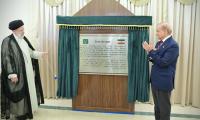Global polio watchdog says key areas of Pakistan have some of the worst levels of routine vaccine coverage in the world; proposes ways to overcome remaining imperfections
Islamabad
In its 14th report released on Friday, the Independent Monitoring Board (IMB) of the Global Polio Eradication Initiative (GPEI) has pointed out that while the polio programme in Pakistan is delivering “near to peak performance,” the numbers of children missed in polio vaccination rounds remains “too high for comfort,” and that if it does not initiate a new transmission immediately, it could emerge as an unwelcome outbreak on the path to eradication.
In reviewing Pakistan, the IMB has gained the strong impression of a high-performing programme, but it believes that another big step is needed by the country to reach the pinnacle at which polio transmission is stopped for good.
“Particularly, large numbers (of children) are missed even after subsequent catch-up activities have been completed. This must become a key metric in the fight against polio,” states the report, which is titled ‘Every last virus.’ Looking at the polio programme’s performance in the last three seasons (covering 15 immunisation rounds) is revealing. In Pakistan, even after attempts to go back to communities to find the children who had been missed, the approximate numbers unvaccinated were: 767,000 (low season 2016); 760,000 (high season 2016); 858,000 (low season 2017).
Even after the last apparent case in Pakistan and Afghanistan, the IMB has urged the two countries to sort out the remaining imperfections in their programmes if they are to build resilience.
The single biggest issue confronting the polio programme in Pakistan and Afghanistan is how to effectively reach the large numbers of children who are on the move with their families. The IMB believes that “follow-up visits are still not finding enough of such children.” To this effect, the global polio watchdog has called for involving local people, taking an enhanced approach to micro-planning, and establishing flexible arrangements for visits.
In order to reach known nomadic groups, the IMB has recommended the use of health camps providing a range of public health services to engage them. However, the greatest conundrum is how to reach the much larger numbers of mobile children who are not part of nomadic communities. The polio programme calls these children “guests.” This term signifies that they travel with their own family regularly from one dwelling to another staying with wider family or friends for variable periods of time. They make up some 90% of what the polio programme has been calling the “high-risk mobile populations” of children.
In short, the IMB has stressed that actions tailored to reach the large and highly mobile population of children moving with their families across Pakistan, into Afghanistan, and back again, must be completely integrated into all aspects of the performance of the polio programme at a local level.
Referring to routine immunisation, the IMB has pointed out that despite some recent improvements, “key areas of Pakistan have some of the worst levels of routine vaccine coverage in the world” despite heavy investments by GAVI. “It is recommended that a special task force be assembled to bring about a major transformation in performance within the next six months,” the report stated.
While acute accid paralysis (AFP) surveillance has improved across all provinces of Pakistan, the IMB report still talks about “persistent pockets of poor performance.” Environmental surveillance has detected wild poliovirus transmission in the absence of infected cases of AFP, particularly in Punjab. “Pakistan needs to further improve AFP surveillance in and around known pockets of wild poliovirus transmission including in districts that are not in the highest priority group,” it states.
The IMB lists a couple of key priorities for action with reference to Pakistan’s polio programme. To begin with, it calls for an innovative and transformational solution to vaccinate the large numbers of so-called “guest children” who are within the large high-risk mobile population. It believes that continuing with the current approach will not reduce the numbers of “still missed” children from hundreds of thousands to hundreds in less than six months.
Secondly, the IMB believes that a dramatic and immediate turnaround is needed in the low level of routine immunisation coverage in the polio reservoirs in Pakistan and Afghanistan. It terms the current state of routine immunization as being “a stain on the programme’s record of improved performance.”
Among several other recommendations, the IMB has called for the establishment of a system of innovation hubs in both Pakistan and Afghanistan. “They should seek the input of local people, individuals entirely outside the public health field, and young people who are not used to working in formal organisational structures. They should be directed initially to find innovative solutions to problems described in this report,” it states.
In a general comment applicable to all the three remaining polio endemic countries i.e., Pakistan, Afghanistan and Nigeria, the IMB has expressed concerns about the quality, reliability, capacity and authenticity of surveillance data in areas across the whole polio programme. “The quality of the system of surveillance in parts of all three endemic countries is not consistently high enough to be sure that every virus is being detected,” the report states, stressing that current optimism must be tempered with a realism about the risks and challenges that remain, as only if the appropriate balance is struck can the programme succeed soon.
A representational image of young people working in a company. — AFP/FileIslamabad: The National Vocational and...
Ambassador of Kazakhstan to Pakistan, Yerzhan Kistafin speaks during a book launching ceremony. —...
Ahmed Jawad A A. Rabei, ambassador of the State of Palestine , VC Riphah University Prof. Dr Anis Ahmed and Dr...
The Department of Food Science & Technology building in the University of Karachi. — University of Karachi...
The printed papers of cigarettes can be seen in a cigarette factory. — FBR Website/FileIslamabad: Health activists...
This representational image shows an array of colourful flowers on display on December 3, 2023. — Facebook/Parks and...







